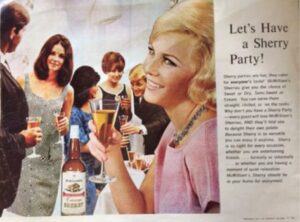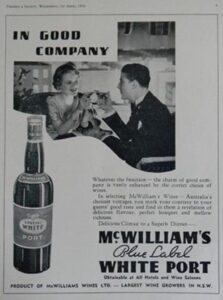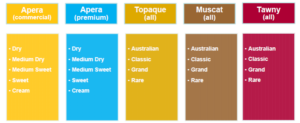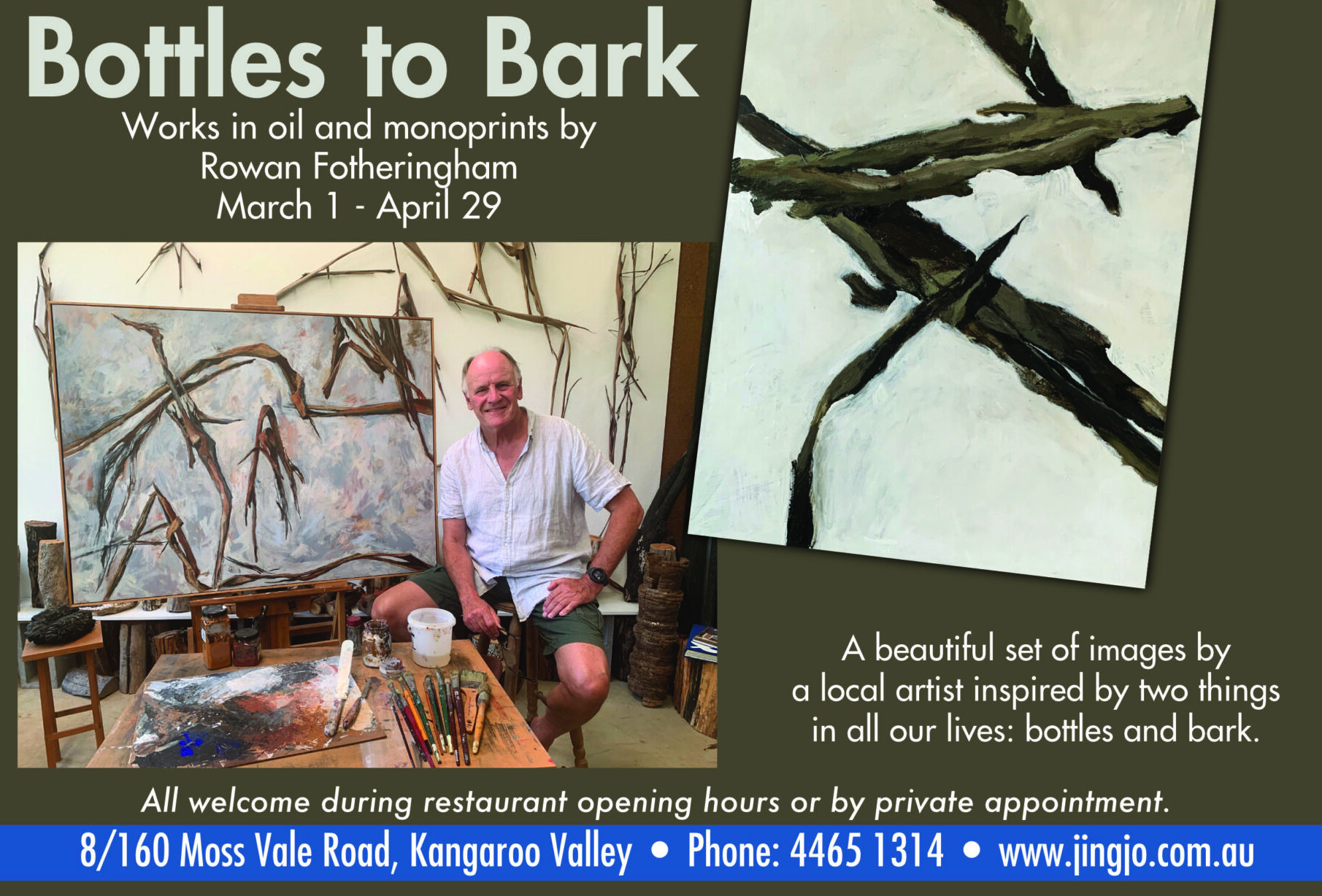Interest in fortified wines has decreased dramatically, with no real interest to many people in Australia today as new styles and types of alcoholic beverages spring up every day. Sales are less than 10% of total wine sales, and have been on the decline since the 1970s – flash-backs to those grand old days of grabbing a tipple of your favourite drop are very much changed. In the 1950s to early 1970s fortified wines sold 10 to 1 against table wines in Australia, with some of the biggest producers in Australia coming from mainly old family-run businesses like Penfolds, McWilliams, Angoves, Seppelts, Morris, Campbells, Saltrams and Lindemans, which were contributing to the production of 86% of all table wine grapes destined for fortified wines. From the mid 1850s to the early 1960swe were exporting our fortified wines to the UK. Australian taste for fortified has declined since the highs of the 1950s with the introduction of better table wines inspired by immigrants after WW11.
There are many more producers who got involved in export, and as the UK market referred to it as ‘Colonial Wine’ it was exported in vast quantities to the UK until the they joined the EEC, where the duties were lowered for Portuguese and Spanish wines and made Australian fortified wines too expensive. Some of these family-run wineries have been brought under one banner, e.g. Treasury Wines – Penfolds, Saltrams, Lindemans and Seppelts and others, especially in the Rutherglen region have continued to sell some amazing fortified wines. Visit the cellar doors and experience fortified with new insight!


So, what is fortified wine?
Fortified wine is table wine that has had a brandy spirit added to it during fermentation or at the end of fermentation (the bit where sugar is turned into alcohol) depending on the style.
The added brandy spirit stops the fermentation by killing the yeast leaving unfermented sugar in the fortified wine, creating the rich or sweet taste. At the end of fermentation for dry style Apera Sherry leaving no sugar left.
The addition of the spirit also results in a higher alcohol content than normal wine, usually ranging from 17.5% to 22% ABV.
Overview of different types of fortified wines in Australia

Australian Fortified Classification – from 2010 new guidelines were put in place by Wine Australia:
Muscat/Tawny/Topaque–fresh aromas and vivid flavours, average age 2 –5 years, 180 -240 grams residual sugar/ litre.
Classic Muscat/Tawny/Topaque–greater richness and complexity displaying distinctive aged characteristics, average age 5 –10 years, 200 –280 grams residual sugar/ litre.
Grand Muscat/Tawny/Topaque–more intense aromas and flavours than Classic, showing more texture and layering of flavours, average age 10 –15 years, 270 –400 grams residual sugar/litre.
Rare Muscat/Tawny/Topaque–the pinnacle of the richest finest wines in the cellar, breathtaking in complexity, texture, depth of flavour, average age 20 years +, 270 –400 grams residual sugar per litre.
[Insert ‘In Good Company’]
[Caption] Fashion and Society Magazine 1924
Different Types of Fortified Wines
Tawny (old term Port) is made from red grapes such as Touriga, Tinto, Shiraz, Mataro, Grenache, Cabernet Sauvignon and aged in oak barrels, exposing it to gradual oxidisation and evaporation which concentrates the flavours from popular wine regions like Barossa Valley (SA), Rutherglen (VIC), Riverina (NSW) and numerous smaller regions around Australia. These significant fortified wine places allow for the maturation in the oak barrels in the warmth of summer and are found in the rooftops over the winery.
In general, ‘port’ is only made in Portugal around the Duoro Valley/River from the 17th century and is the second oldest protected wine region behind Chianti. The growth of port was due to the English acquiring the taste for it in the early 1700s and the export trade blossomed. Oporto is the hub for all the trade, but also the meeting place for all the warehouses full of casks of port and were owned by the shippers and brands like Cockburn, Dow, Croft, and Sandeman.
Styles
Ruby: more of a medium wine and maturation will add very little to its ‘fresh’ taste. Colour is as its name suggests – Ruby Red.
Tawny: blended wines (aged in oak barrels and casks from five to up to 100 years. Tawny is ready to drink when bottled, as most of the maturation has already taken place in that period. They are often blends of several years. Colour can range considerably but usually is darker and browner (tawny) than vintage.
Vintage: made from the wine of one particular year. They usually spend 12-18 months in wood and then are left to develop in the bottle. 20+ years is quite normal. Colour starts off purplish, then becomes dark red – losing the violet colour. Red.
Food Match: Tawny goes beautifully with cheese, with dark chocolate or nuts as a winter warmer. It can also partner exceptionally with many classic desserts such as a sticky date pudding.
Topaque (Old Term Tokay) is characterised by intense flavours of golden syrup, butterscotch, and cold tea aromas.
The name Tokaji is used by the Hungarians in Slovakia for a wine they have been producing since the 18th century. It was known as ‘the Wine of Kings, King of Wines’, but history dates the vines back to 1576, so it’s been around and was the first known appellation for wine control standards. The standard is controlled by puttonyos which is based on the content of sugar and sugar-free extract in the mature wine. Aszu ranges from 3 puttonyos to 6 puttonyos and then another category above that called Aszu-Eszencia (5 -6 % Alc only). The best was never sold and were kept for the Imperial monarchy up to WW1. A bottle of Royal Saxon Court was sold at auction for £1,955 in 2008 at Christie’s.
Topaque (Tokay) is white and is made from the grape variety Muscadelle. The name change from Tokay to Topaque’s commenced in 2010, but there is a 10 year grace period.
Maturation takes place in old barrels and the wines can remain in these barrels for up to 50-60 years. The blending technique is termed ‘solera’ (roughly translated from Spanish to mean a stack of barrels).
Food Match: Topaque goes beautifully with desserts such as chocolate mud cake, Christmas pudding or simply drizzle some over vanilla bean ice cream for a dessert with a difference.
Muscat has an intensely rich aged raisin flavour combined with subtle hints of oak aged notes. Younger wines can have a ripe citrus character and can be very floral on the bouquet. This style is truly an Australian marvel and amazingly delicious. (Hint: pour over good vanilla ice cream). Its origins trace back to the Egyptians and Persians around 3000 to 1000 BC.
Muscat starts out being a late harvest wine with the grapes allowed to stay on the vine until they are in a partially raisined state, they are then pressed and go through partial fermentation before being halted with the addition of brandy spirit, as with other fortifieds.
Muscat is red and is made from the grape variety Red or Brown Frontignac, also known as muscat à petits grains; in fact there are many uses besides fortified made around the world. The Italian make Moscato Asti, and it’s used a lot for french fortified wines known as vin doux naturels, as do many other wine-growing countries around the world.
Grading of Rutherglen Muscat – established around the same time as we changed over to the new classification for names in 2010.
Rutherglen Liqueur Muscat has average age of 3 to 5 years, Classic Rutherglen Muscat 5 to 10 years, Grand Rutherglen Muscat 10 to 15 years, and Rare Rutherglen Muscat 20+ years.
Food Match: Muscat is great with desserts such as pecan pie or salted caramel, with some chocolate or simply by itself.
[Insert ‘Let’s have a party’]
[Caption} Women’s Day 1966
Apera (old term Sherry) is made from white grapes like Palomino, Moscatel and Pedro Ximenez and produced in a variety of styles, ranging from dry and light through to darker and heavier versions ,and then there are sweet, dessert styles as well. Apera is very versatile and can be drunk as an aperitif, as a dessert wine and used in various cocktails made from white grapes.
Sherry is made in Spain, right at the very entrance way to the Mediterranean Sea in Jerez. It’s been making wine since the Phoenicians introduced it in 1100 BCE, continued by the Romans and the Moors who brought in distillation. Its growth again came from the English via an invasion by Francis Drake on the port of Cadiz where 2,900 barrels were loaded onto Spanish ships and taken to England in 1587. Many British importers set up cellars in Jerez to maintain the trade with popular known brands like Harvey’s and Croft.
Styles
Dry – nutty, clean & fresh (Old term: Fino or Manzanilla – serve chilled).
Medium Dry – almond characters balanced with a hint of subtle sweetness (old term: Amontillado).
Medium Sweet – intense, rich, lingering fruit characters combined with nut driven flavours (old term: Oloroso).
Sweet & Cream – intense fruit flavours with a pleasantly soft mouth.
Food Match: Dry & Medium Dry styles paired with nuts, olives, sun-dried tomatoes or soup. Medium Sweet can be used to accompany fruit-based desserts like plum puddings, fruit tarts or fruit salads. Sweet varieties can be used to accompany desserts that are rich but not overpowering, such as crème caramel or golden syrup dumplings. (Pedro Ximenez and Moscatel). Cream styles work with fruit-based desserts, fruit salads and of course in trifles.
Michael Quirk





